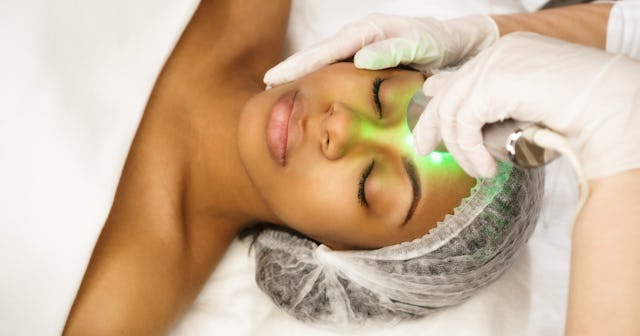Can Color Therapy Help You? Learn More About This Healing Modality
Find out how to get in tune with yourself.

What would a world look like without color? Real talk: It would be pretty dull. Colors infuse our life with so much beauty and brightness — and more. Have you ever noticed that you feel happy and extra energized when you’re surrounded by colors, whether in a gorgeous garden or admiring a stunning rainbow? There’s a reason for that. Chromotherapy, otherwise known as color therapy, is an alternative therapy based on the idea that color and colored lights have physical or mental health benefits.
It’s thought that certain colors and their frequencies help to heal physical and emotional ailments within the human body. Everything from depression to anxiety to chronic pain may be alleviated by exposure to the right colors. Interested in learning more about how this therapy might be able to help you? Read on for all the intel, including tips for adding more color to your world.
What is color therapy?
Color therapy is said to have originated at least around the time of Ancient Egypt. For example, Egyptians believed in the power of light (including the sun). They also believed in using different colors to promote healing within the human body. Today, this type of therapy uses color and light to treat physical or mental problems by balancing the body’s energy centers, known as chakras. This therapy is based on the premise that different colors evoke different responses.
Each chakra is associated with a specific color relating to a specific type of energy and area that makes up our everyday lives — think everything from our relationships to communication and beyond. Proponents of this specific therapy believe that illness is caused by or causes an imbalance in the chakras. For example, the root chakra, which is symbolized in red, is located at the bottom of the spine. It represents our sense of security and place within the world. If we are feeling ungrounded or anxious, color therapy — specifically the color red — would be used to help heal the imbalance and resulting ailment.
What are the color therapy chart colors?
Colors are special, and each one can affect your emotional state differently. Below, check out our color breakdown, which details the meaning of each one.
Green: Balance, harmony, love, social, acceptance
Yellow: Fun, humor, logic, creativity
Blue: Calmness, peace, love, inner peace, devotion
Violet: Imagination, art, intuition
Red: Passion, stability, spontaneity
Orange: Pleasure, optimism, enthusiasm
What are the benefits?
The benefits are wide ranging: From healing anxiety to depression, seasonal affective disorder, circulatory issues, chronic pain, sleep problems, and more.
While many present-day natural healers use this modality with their clients, traditional Western medicine hasn’t accepted or used color therapy as much. In fact, scientific backing on it is limited. Granted, that makes sense as it’s fairly new as far as modern medicine is concerned. However, there has been some evidence to support that the usage of light and color can be healing for certain physical and mental issues. For example, light therapy is used to treat seasonal affective disorder, a type of depression that typically affects people during fall and winter.
Additionally, yellow light therapy has been used to treat eyesight issues, including night blindness or difficulties seeing at night. Red light therapy has been used to treat everything from acne scars and wrinkles to pain relief like arthritis to muscle fatigue. And orange light has been used to treat bronchitis, asthma, and other respiratory issues.
How can you use color therapy?
There are several ways that can be as easy as wearing a pair of glasses or using a coloring book. Here are some of the most popular methods.
Color therapy glasses: There are myriad color therapy glasses available to help stimulate different emotional responses depending on the lens color. For example, need to feel more empowered? Choose a red lens. Note: Unlike sunglasses, color therapy glasses are only supposed to be worn about 30 to 60 minutes a day.
Color therapy lights: Using color therapy lights can be as simple as changing the light bulbs in your home with the corresponding color that offers the therapeutic benefit you desire. You can also purchase lights. For example, blue lights help you feel more alert, while red lights can help you unwind before bed.
Color therapy book: There are also several color therapy coloring books that help to soothe and de-stress.
What color attracts the human eye most?
The human eye is most sensitive to light at a wavelength of 555 nanometers, which is bright green. So, the next time you go jogging or biking throw on a lime green sweatsuit. This shade is one of the three source colors out of 10 million tones that is most visible to the human eye. This color is even visible from high up in the air.
Color Therapy Exercises
If you want to incorporate some color therapy into your day-to-day, try these exercises below to get in tune with yourself and color!
- Paint without a plan and let your brush guide you.
- Paint your feelings or what’s going on in your mind.
- Journal using different colored pens. If you’re feeling anxious, try writing in green. When feeling uninspired; write in red. Or if you’re feeling down in the dumps, write in yellow!
- Turn on some music and close your eyes. Try to paint the piece without looking at the canvas and let the music guide your strokes. When you’re finished, see if your image matches the song and try to remember why you made certain marks.
- Take your art to the next step and draw your painting outside. Turn the driveway into a vast canvas or pin a large white sheet on the ground. The goal is to go big so you can feel limitless and a sense of artistic freedom in this space.
This article was originally published on